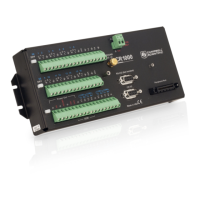Appendix A. CRBasic Programming Instructions
Table 140. Asynchronous-Port Baud Rates
1
Autobaud: measurements are made on the communication signal and the baud rate is determined
by the CR1000.
A.14 Variable Management
ArrayIndex
Returns the index of a named element in an array.
Syntax
variable = ArrayIndex(Name)
ArrayLength
Returns the length of a variable array. In the case of variables of data type
STRING, the total number of characters that the array of strings can hold is
returned.
Syntax
ArrayLength(Variable)
Erase
Clears all bytes in a variable or variable array.
Syntax
Erase(EraseVar)
FindSpa
Searches a source array for a value and returns the position of the value in the
array.
Syntax
FindSpa(SoughtLow, SoughtHigh, Step, Source)
Move
Moves the values in a range of variables into different variables or fills a range of
variables with a constant.
Syntax
Move(Dest, DestReps, Source, SourceReps)
A.15 File Management
Commands to access and manage files stored in CR1000 memory.
CalFile
Stores variable data, such as sensor calibration data, from a program into a non-
volatile CR1000 memory file. CalFile() pre-dates and is not used with the
FieldCal() function.
589

